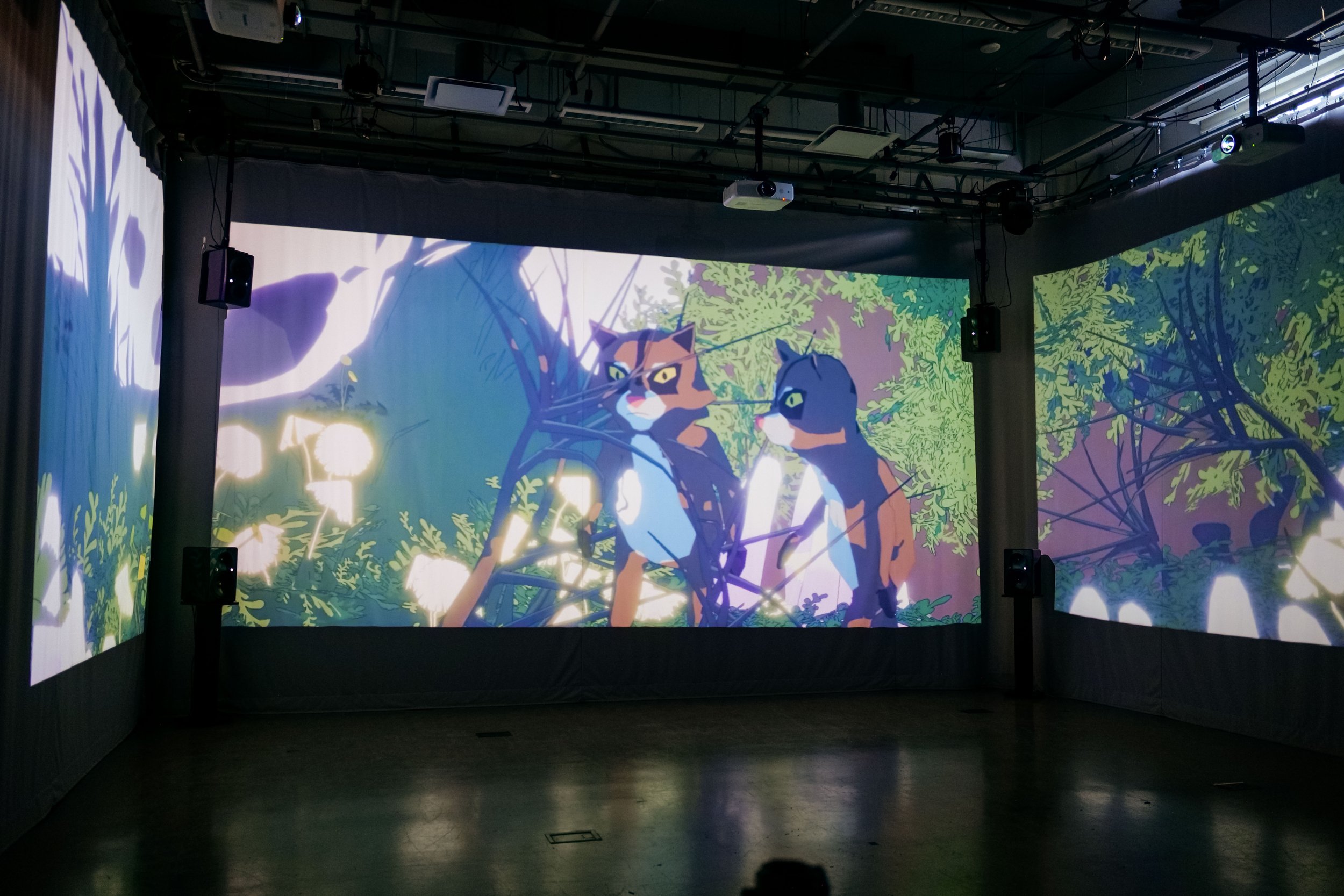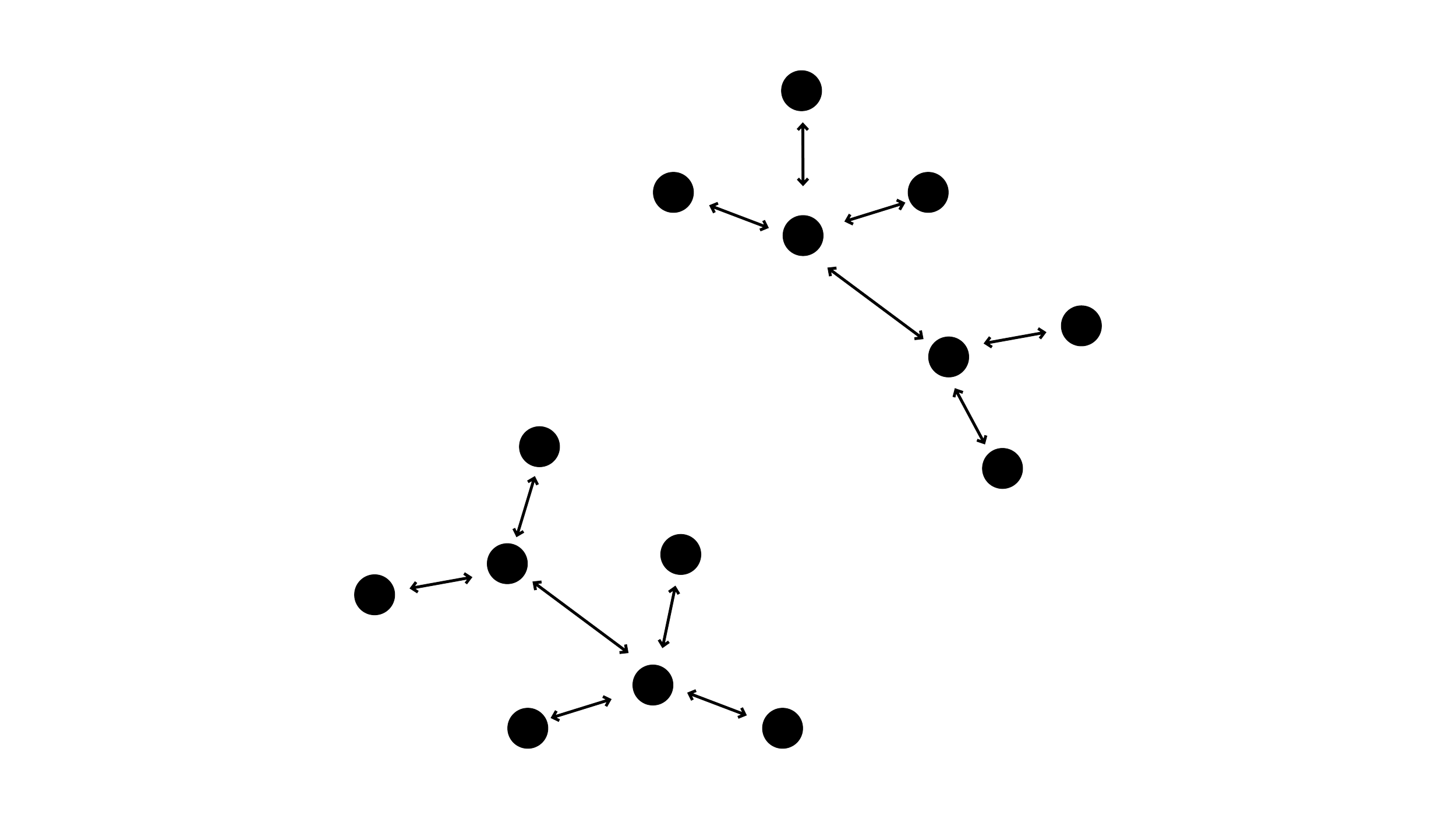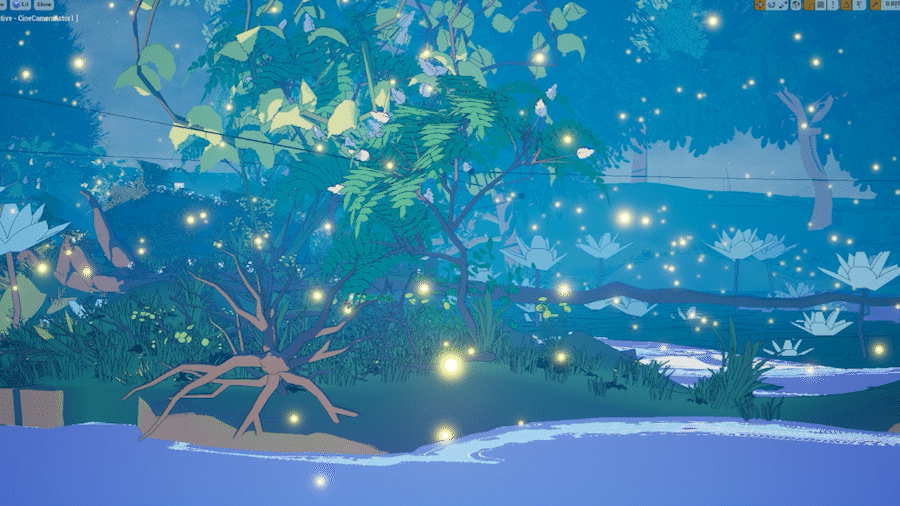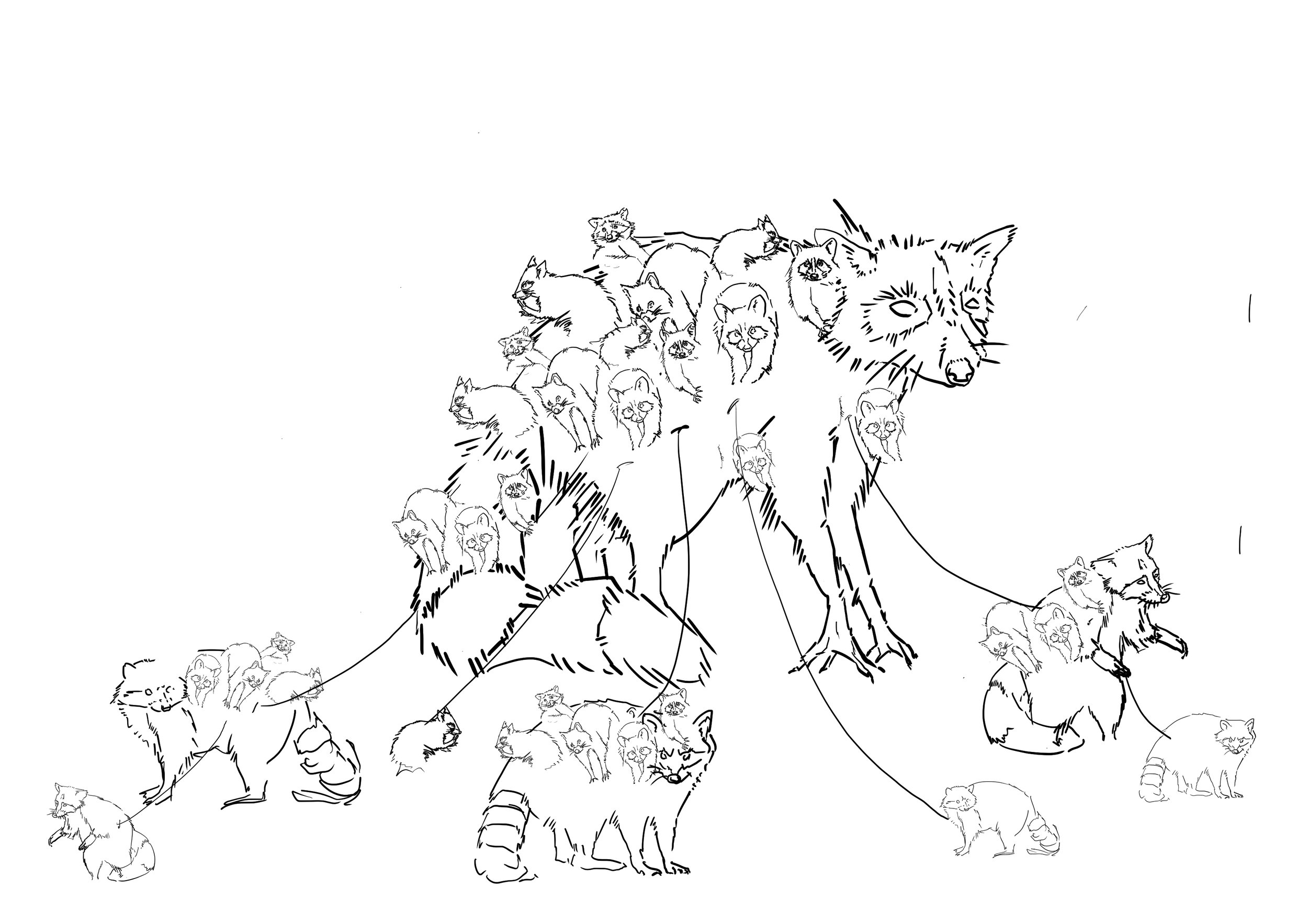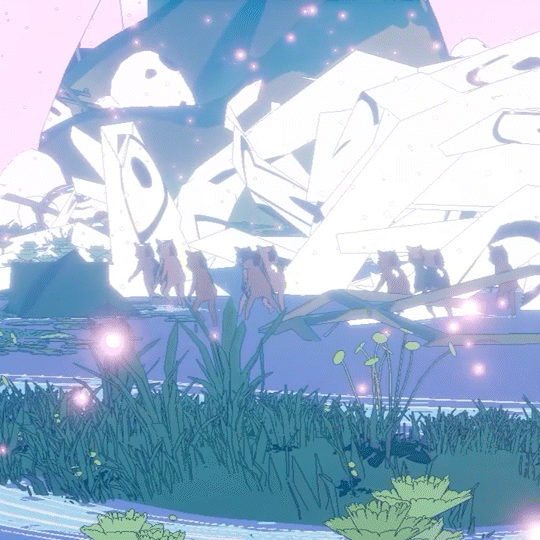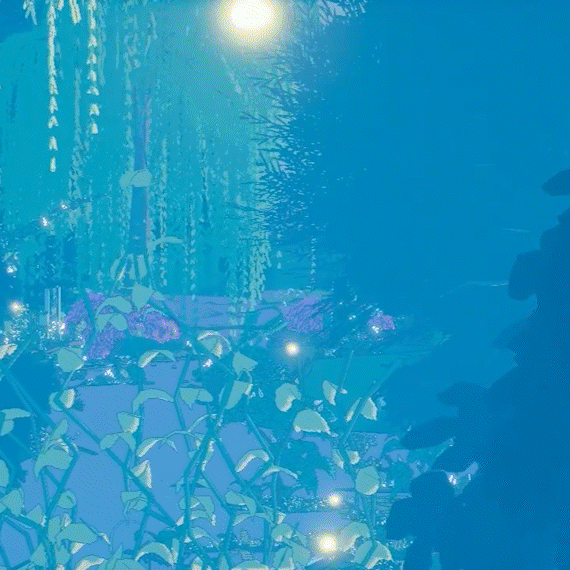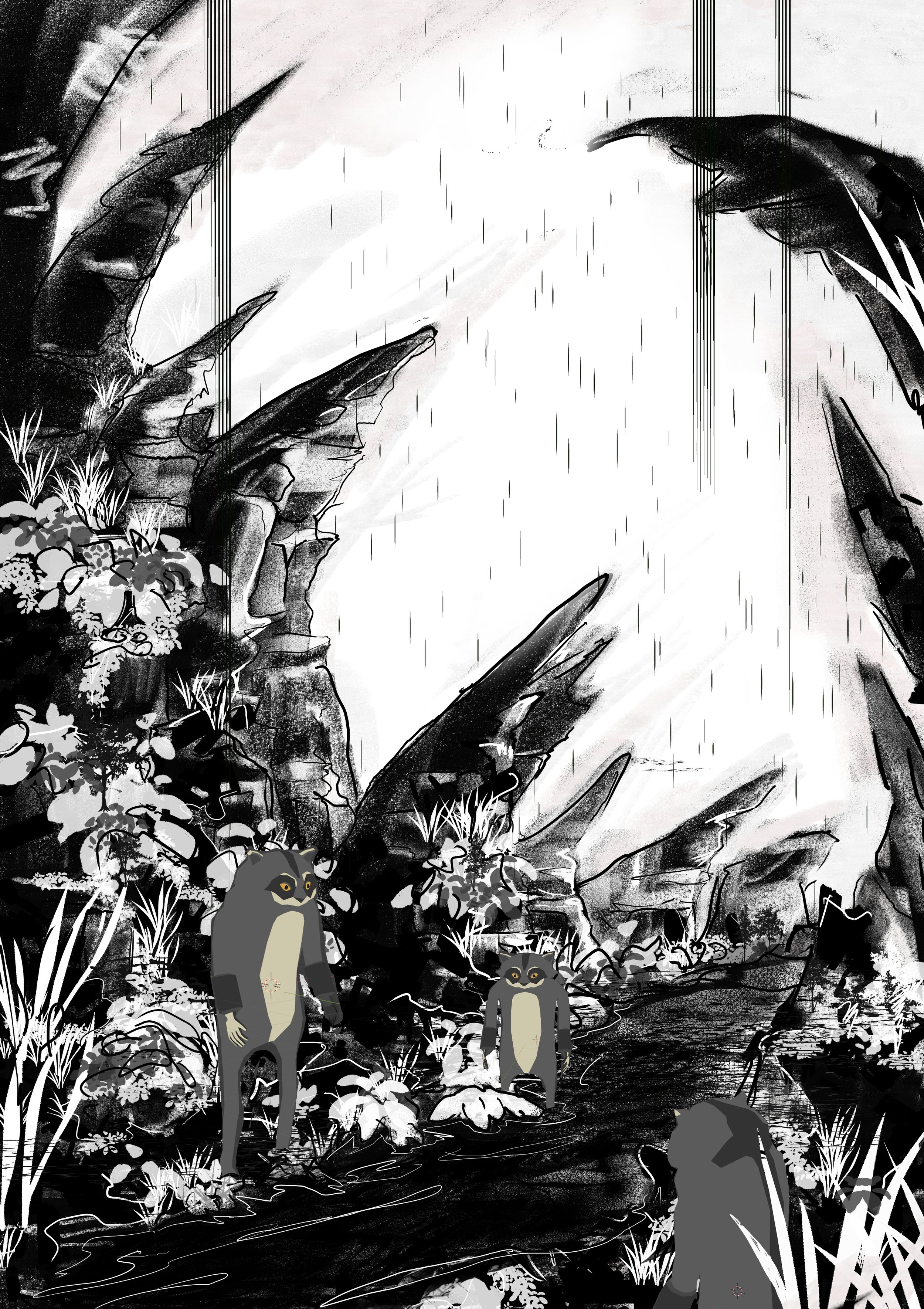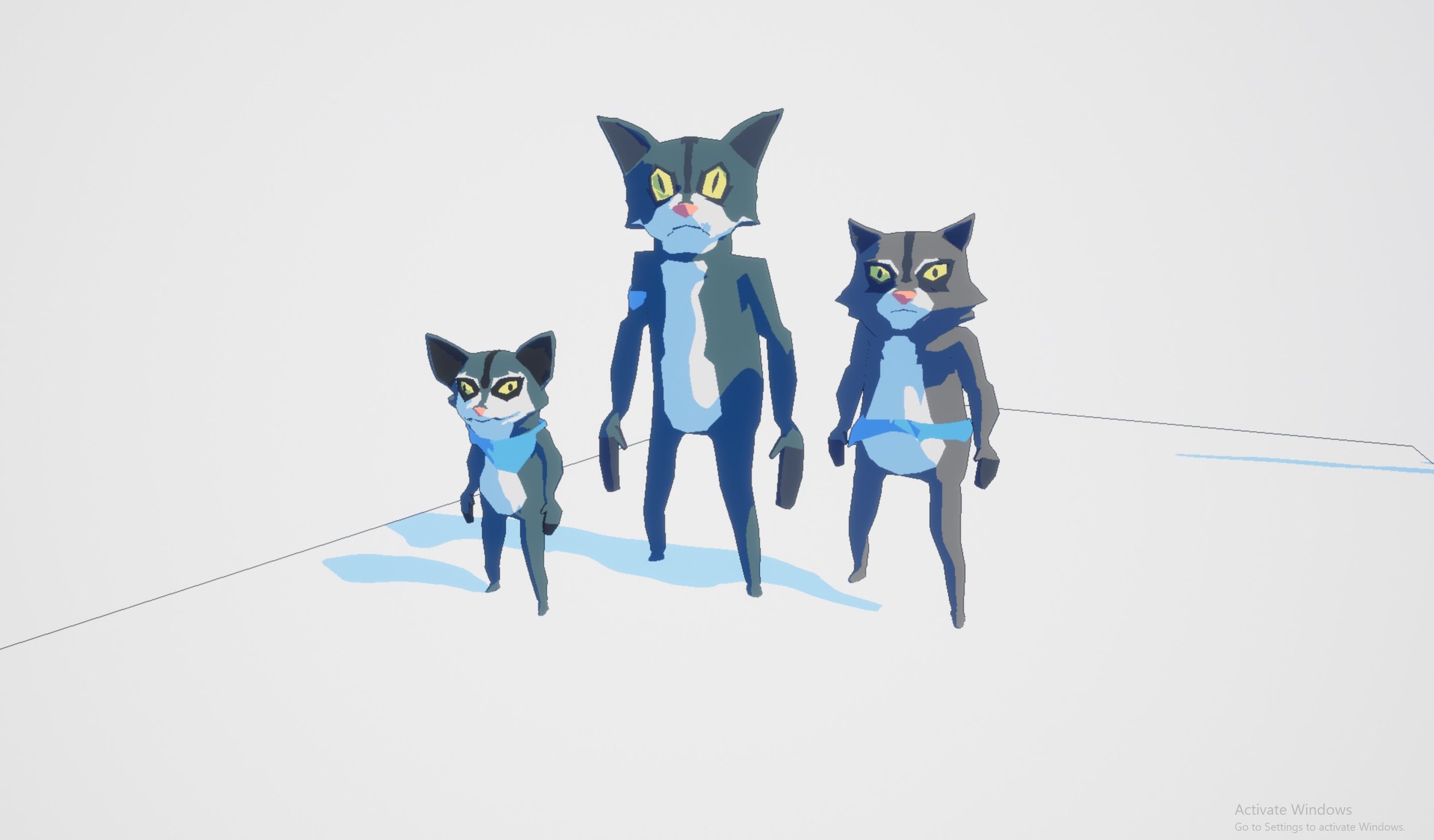Entangled Forest, 2022
Artificial Life Simulation & Installation
Real-Time, Simulation, Artificial Life, Narrative
The Entangled Forest is an artificial life simulation that attempts to create a cinematic narrative. The simulation takes the form of a wide-screen projection documenting the lives of anthropomorphic raccoon tribes in a post-post-apocalyptic artificial ecosystem modelled after Toronto suburbs. The programmed behaviours of the characters; non-player characters (NPC) draw inspiration from the field of artificial life. Artificial life sometimes referred to as ALife or AL is a field of study dedicated to the understanding of biological life by synthesizing life within a computer simulation. While the goals of traditional artificial life models are often scientific or artistic, such as to calculate fitness criteria for evolution in response to environmental stimulus. Practitioners of Artificial life rely on story, narrativization, and metaphor to describe, validate and process their findings. This project is designed to elaborate on artificial life's narrative and storytelling potential through cinematics and documentary features built into game engines. The development of this installation focuses on examining non-traditional methods of storytelling: like experimental and expanded cinema and independent video games, in particular, narratives that deviate from the formulaic tropes presented abundantly in western cinema such as the hero's journey and the three-act structure. The documentary hopes to capture in real-time how archetypal characters and tribes interact with each other and respond to transformative events and the roles they fulfill in society. The worldbuilding elements such as characters and environments draw inspiration from the role of mycorrhizal fungi in nature as redistributors of resources and emergent internet culture. The art direction of Entangled Forest is inspired by surrealist illustrations of Jean Giraud Moebius and Studio Ghibli movies.
Role: Graduate Student, MA
Organization: York University
Technology: Unreal Engine 4.25, Blender, TreeIt, Touchdesigner, Plask
Worldbuilding & Conceptual Development
Entangled Forest is a fictional future that envisions algorithmic phenomena and media spaces acted out by programmed characters in a distant-future dystopia. The worldbuilding of this project takes inspiration from the internet's ability to generate its own culture, history, and emergent phenomena. This project hopes to develop a rhizomatic approach to telling stories through worldbuilding, artificial ecosystem, and cinematic frameworks available in game engines. A narrative could be generated by placing NPCs into a complex world to examine their reaction to external threats, formation of social structures, alliances, and genetic transformation as they attempt to survive in this world. This project uses concepts like the meme or hyperstitions to enrich the narrative. Hyperstition is an expression that combines hyper and superstition a term coined to describe a concept of fiction that can transmute itself into reality (Carstens, 2010).
Macro: The creation of the physical environment in which the story will take place
In this world, certain areas are inexplicably damaged and a variety of fungi have begun to fruit in the surroundings replacing the trees and affecting the fauna. The exact reason for human extinction in this world is unknown. This area of this location is roughly 1.40 square kilometres, it has one large creek that runs south to north and several shallow marsh-like bodies of water. Two tribes of raccoons have emerged one large group of stationary raccoons that inhabit a central location called settlers and smaller groups of nomadic tribes that travel near waterways. The location draws topographic inspiration from a real Toronto suburb, though no trace of human existence remains except for ruins of infrastructure, streets, street lights etc.
Development of “element x”
The world’s element x or foundational oddity of the world (for example the force in the Star Wars series (1987–present) or magic in Harry Potter (1997-2007)) centers around a mycorrhizal network. In nature, a mycorrhizal network is a network of trees or plants in a forest that has formed an underground network through a root-like fungal structure called a mycelium. Through this network plants and trees are able to store and pass information and re-distribute nutrition. The network of Entangled Forest is able to telepathically connect infected creatures in this world creating a hive network, a hyperstition object capable of generating its own myths and legends.
Mycorrhizal fungi living inside a root. Image reproduced from Sheldrake, et al. (2017)
Micro: The creation of the cultures that result from elemental factors
The Entangled Forest’s characters and cultures were inspired by the book The Mushroom At The End Of The World. The author, anthropologist Anna Tsing suggests that humans can draw inspiration from the role of fungi in an ecosystem. Tsing relates the resilience of the matsutake mushroom to exist in precarious environmental conditions to the economic circumstances that allow foragers of the matsutake to survive within the dominant capitalist economy. Mushrooms like the matsutake are an expensive delicacy, they grow in ecologically degraded forests. The mushrooms can not be farmed using traditional farming practices; they must be foraged and harvested by hand. The creatures of this world, bipedal raccoons have established differentiated cultures according to organisms that have emerged around their habitat. Some communities have settled around resources like water and food while others are nomadic and travel along waterways in search of resources.
Nomadic Raccoon Tribe
The nomadic raccoon’s survival skills are tied to their ability to adapt to their surroundings, their morphology and skills have evolved to survive and vary among the individuals in the tribe. The individuals in the tribe can work in teams to find resources or address hearts but their audible range is limited.
Settler Raccoon Tribe
The settler tribe’s survival abilities related to their collective strength and their ties to the mycorrhizal network, their behaviour and social structure were inspired by a hivemind social structure. Communication within the tribe is facilitated by the mycorrhizal network. The ethos of the tribe is to work collaboratively, share information, and respond as a collective. The morphology and skills of the individuals in the settler tribe are similar most being of the common variety, little variation exists in their appearance.
Emergent behaviour: Culture, History, Myths
The creatures that inhabit the surrounding areas have been infected by the fungi’s spores and can access and utilize a mycorrhizal network that resides deep within the soil. They develop visible growths on their bodies and can share information like locations of potential threats and resources. The fungi network is also able to reallocate nutrition resources. Due to the development of these abilities myths and legends are created within the infected cultures. A key figure is located within the mycorrhizal network, a manifestation of all the creature's thoughts in the network, an egregore. The concept of the egregore has emerged in some religious and occult contexts but the term has no standard definitions. Wikipedia summarises the concept as an occult concept representing a non-physical entity that rises out of the collective thoughts of groups of people, the modern definition of egregore can also encapsulate non-occult concepts like a corporation or the meme (“Egregore”, Wikipedia). The egregore is a ghost of the hivemind, a physical representation of the desires of the system. The egregore is merely a phantom of the network and ceases to exist if not desired. The mycelium of Entangled Forest intends to act as a catalyst to generate emergent behaviours, myths and histories just as the internet produces its memes, culture and history.
Programming behaviour
Entangled Forest was developed using Unreal Engine 4, a game development platform that offers features such as AI simulation and photorealistic rendering. The characters’ behaviour was programmed in Unreal Engine 4 utilizing its built-in artificial intelligence solution, the system utilizes a behaviour tree and state machine.
Basic Needs, States And Sequences
The character's behaviour is programmed using Unreal Engine’s state machine-based AI feature. The state is set in response to a basic need that needs to be replenished. This response is broken up into several smaller tasks and various branches depending on the morphology of the character. Lower priority states will be evacuated if a higher priority state is activated, for example, if a creature searching for food encounters a threat the Hungry state is evacuated and the threatened state is activated. There are six basic needs, Health, Stamina, Hunger, Thirst, Sleep, and Reproduction. There are seven basic states, Hungry, Thirsty, Sleepy, Reproduce, Threatened, Defence, and Flock. Some basic needs correspond with states, (Hunger - Hungry, Thirst - Thirsty, Sleep - Sleepy, Reproduction - Reproduce) when each of these basic needs reaches a critical level they execute their corresponding state. Other states are activated by visual perception. States like Threatened and Defence are activated when the character perceives a threat it must flee or attack. The flock state is a passive state that manages the character's distance from its tribe. Health and stamina are passive basic needs they do not trigger a state but effect the character's decisions and physical abilities. A diagram of the behaviour tree can be seen below.
Aesthetics and design
The aesthetic of this world draws inspiration from sources like anime, movies, media, and video games. But the two most significant sources of inspiration were the work of Moebius aka, Jean Giraud and the background art from Studio Ghibli movies. Miyazaki's backgrounds have a very rich texture that combines a painterly approach using traditional techniques (e.g. watercolour or gouache) and a dense placement of scene elements like foliage. This forest scene below (bottom right) is from My Neighbor Totoro (1988) and is an almost monochromatic colour scheme, it utilizes a variety of foliage in greens with subtle accents of coloured flowers. Moebius's illustration utilizes a prominent outline, that helps defines the textured parts of the composition. The colours are often pastel or desaturated, using gradients to signify depth. The aesthetic and render style of the Entangled Forest world, attempts to combine the textural qualities of Ghibli films and the illustrative style of Moebius. This project’s render style uses a defined outline, a cell shader, and a variety of custom-made low poly 3D models. Dozens of custom low poly assets were created in Blender, a free and open-source 3D modelling software to suit the cell shader aesthetic. I followed the big, medium, and small rules to help create the appearance of natural density, and texture in the composition and scene elements, bottom right is an example of a forest floor scene from Entangle Forest, a big root, followed by a variety of medium-sized shrubs and small moss and micro flowers.
Foliage
The majority of foliage in this world was custom-made, each plant was site-specific, found locally in a western Toronto suburb, for example, Daisies, Dandelions, Milkweed, Staghorn Sumac, etc. The foliage was designed in a software program called TreeIt, a 3D tree generator that utilizes a list of parameters like trunk thickness, leaf size etc, to generate trees, shrubs and flowers in real-time.
human infrastructure
The human infrastructure like buildings, and street furnishings like signage, stop, rubble, signs, etc., were designed to be modular. I created a variety of floor types, and types of walls some interior and exterior, balconies with or without sliding doors, pillars interior walls etc., in various stages of degradation. The pieces can fit together to create a variety of differentiation in assets.
Landscape
The landscape is broken up into three zones, the mushroom forest, ruins, and waterways. There are also transitional spaces like grasslands in-between each of these spaces. The landscape is modelled after a real location, located in Etobicoke, Ontario, the terrain model was created by exporting data from OpenStreetMap and converting it to a 3D model using Houdini. In Houdini, the terrain was eroded to simulate the passage of time. This model was imported into Blender and converted into a heightmap, an image that stores elevation information. Unreal Engine can convert heightmap into terrain this saved a lot of time in modelling the environment or importing a massive 3D model
Character Design
The characters were designed for attributes like strength, speed, intelligence, etc. Their morphology was designed to fit their abilities and skills. The mouse is much smaller than the common raccoon, it has a larger head and smaller arms. Similarly, the wolf is much taller than the common raccoon, it has longer arms, and much larger ears and eyes. Within the two tribes identifying features were added so the viewer can differentiate between the two groups of characters, when a character is instantiated it is assigned a species and a tribe, depending on its parent's characteristics. Each character is programmed with every form of markings (e.g. cloth or fungal spots or coloration).
Animation
These models were created in Blender, they were rigged using a website called Mixamo. Mixamo is a browser-based rigging and animation tool, it automatically adds skeletal rigs and animations to non-rigged 3D models. The motion of the characters in Entangled Forest uses a combination of default character movements from UE4 (walk cycles, jumps, landing, etc.), some animations found from Mixamo (swings and attacks), and motion capture created in Plask. Plask is a browser-based AI motion capture tool, it inputs a video file using one camera angle and exports the motion as an FBX. The original intent of this project was to use a motion capture suit to develop bespoke mocap data for each character design, this will be implemented in future iterations.
Other character design
The egregore is designed to be a myth or ghost of the settler tribe. The egregore is the representation of the hivemind, a creature composed of many other creatures bound together. The design of this creature was inspired by the rat king myth, a collection of rats whose tails have intertwined together or become bound together in some way. A fusion of several raccoons into a singular large creature with several creatures protruding out of its back.
The human ghost is another phantom, it is designed to represent the myth of a human from the raccoon's perspective. It is large and moves awkwardly. The eyes are designed to be reminiscent of the headlights of a car at night.
Camera Selection & TouchDesigner controller
The cameras inside this project are designed as characters. Like the raccoon creatures, they are designed using Unreal Engine’s AI perception component. They can see the characters and can identify their tribe. The set of cameras classified as dynamic cameras can follow their character of focus. Each zone has its own dynamic cameras, the settler tribe and the nomadic tribe have two dynamic cameras each. These two camera characters are equipped with a wide and close-up lens, when one camera locates a character it will automatically sync with its partner’s camera. The fixed cameras are stationary and they can rotate in place. If a creature comes into the field of view it can rotate to and focus on that creature. The last type of camera is a rail camera, this camera will fly around the location in a predetermined path to give the viewer an establishing shot of the area. All of these cameras will update the camera array within Touchdesigner with the status of the currently focused character using OSC. The cameras are designed to display sequentially to automatically create various sequences that focus on one character or area for example (scene 1) an establishing shot of an area (scene 2) the next shot a wide angle of a character (scene 3) a close-up of the character (scene 4) a location of interest etc, this could loop and configure automatically.
The Touchdesigner add-on is designed to contain the constantly updating array of cameras and decide which camera needs to be displayed. The program lets you set the number of scenes, and decide on a transition type from scene to scene (cut, fade, move-to and random select). The UI is designed to automatically select cameras by filling out an input field using tags for the desired FOV, desired camera behaviour, location, or the type of creature that is currently in the frame. The user can also add a priority that will re-order the available camera list according to a tag.
Fixed AI Camera
Rail Camera
Dynamic AI Camera
Touchdesigner Camera Selection UI
Camera List
Transition Type List
Installation Design
The installation was designed to use two PCs connected to the same network and a capture card. The game instance runs on PC1, it exports a single ultra-wide video that stretches over three displays. These HDMI out ports of PC1 are plugged into PC2 using a 4-input Elgato Cam Link Pro. The input feed can be manipulated in Touchdesigner and exported in case it needs to be modified for projection mapping or to composite scenes together. Also, two PCs are used in case of failure, the second pc contains a backup instance of the simulation and a pre-recorded video. The video is then exported through the PC2’s graphic card to the projector or display.
